Assessment of the Geochemical Availability and Ecological Risk of Trace Elements in Marine Sediments of the Tremiti Islands
Abstract
1. Introduction
2. Results and Discussion
2.1. Granulometric Composition, Spatial-Bathymetric Trends and XRD Analysis
2.2. Trace Element Content and Contamination Assessment
3. Materials and Methods
3.1. Sampling Area
3.2. Granulometric and Mineralogical Analysis
3.3. Trace Element Analysis
- Phase 1: 0.11 mol L−1 acetic acid for soluble, exchangeable and carbonate-bound TEs.
- Phase 2: 0.5 mol L−1 hydroxylammonium chloride at pH 1.5 for elements occluded in easily reducible iron and manganese oxides.
- Phase 3: 8.8 mol L−1 hydrogen peroxide followed by 1 mol L−1 ammonium acetate at pH 2 for TEs bound to organic matter and sulfides.
- Phase 4: The residue from Phase 3 is digested with aqua regia for TEs fixed in the crystalline lattice of primary and secondary minerals and the sum of TEs content extracted sequentially (Σ Phase 1 + Phase 2 + Phase 3 + Phase 4) is compared to the TEs content extracted in a single step with aqua regia (defined here as pseudo-total content; aqua regia extractable in the previous work).
3.4. Exploratory Analysis of Chemical/Elements Compositional Data
3.5. Pollution and Risk Assessment Indices
4. Conclusions
Author Contributions
Funding
Data Availability Statement
Acknowledgments
Conflicts of Interest
Appendix A
| TE | (mg/kg) | Indicative Values BCR 701 (mg/kg) | Recovery (%) |
|---|---|---|---|
| Cd | 12.1 ± 1.2 | 11.7 ± 1.0 | 103 |
| Cu | 239 ± 17 | 275 ± 13 | 88 |
| Cr | 265 ± 33 | 272 ± 20 | 97 |
| Pb | 134 ± 12 | 143 ± 6 | 94 |
| Ni | 98 ± 9 | 103 ± 4 | 96 |
| Zn | 390 ± 24 | 454 ± 19 | 86 |
| TE | (mg/kg) | Indicative Values BCR 701 (mg/kg) | Recovery (%) |
|---|---|---|---|
| Cd | 0.11 ± 0.06 | 0.13 ± 0.08 | 85 |
| Cu | 38.1 ± 3.3 | 38.5 ± 11.2 | 99 |
| Cr | 54.5 ± 1.7 | 62.5 ± 7.4 | 87 |
| Pb | 12.2 ± 1.6 | 11.0 ± 5.2 | 111 |
| Ni | 37.8 ± 2.5 | 41.4 ± 4.0 | 91 |
| Zn | 81 ± 12 | 95 ± 13 | 85 |
References
- Kumar, V.; Pandita, S.; Sharma, A.; Sharma, V.; Sharma, M.; Cerda, A. Combination of contamination indices and ecological risk assessment index for evaluation of pollution level in sediments. In Heavy Metals in the Environment; Elsevier: Amsterdam, The Netherlands, 2020; pp. 99–117. [Google Scholar]
- Abessa, D.M.; Albuquerque, H.C.; Morais, L.G.; Araújo, G.S.; Fonseca, T.G.; Cruz, A.C.; Campos, B.G.; Camargo, J.B.; Gusso-Choueri, P.K.; Perina, F.C.; et al. Pollution status of marine protected areas worldwide and the consequent toxic effects are unknown. Environ. Pollut. 2018, 243, 1450–1459. [Google Scholar] [CrossRef]
- Orlic, M.; Gacic, M.; Laviolette, P.E. The currents and circulation of the Adriatic Sea. Oceanol. Acta 1992, 15, 109–124. [Google Scholar]
- Bajt, O.; Ramšak, A.; Milun, V.; Andral, B.; Romanelli, G.; Scarpato, A.; Mitrić, M.; Kupusović, T.; Kljajić, Z.; Angelidis, M.; et al. Assessing chemical contamination in the coastal waters of the Adriatic Sea using active mussel biomonitoring with Mytilus galloprovincialis. Mar. Pollut. Bull. 2019, 141, 283–298. [Google Scholar] [CrossRef]
- Villa, B.; Bettinetti, R.; Santolini, C.; Monticelli, D.; Corti, C.; Binda, G.; Mastore, M.; Magni, G.; Pachner, J.; Liguori, G.; et al. Evaluation of the Adriatic Sea pollution using mesozooplankton as an environmental indicator. Chemosphere 2024, 366, 143553. [Google Scholar] [CrossRef]
- Fattobene, M.; Santoni, E.; Russo, R.E.; Zamponi, S.; Conti, P.; Sorci, A.; Awais, M.; Liu, F.; Berrettoni, M. Analysis of Posidonia oceanica’s Stress Factors in the Marine Environment of Tremiti Islands, Italy. Molecules 2024, 29, 4197. [Google Scholar] [CrossRef] [PubMed]
- Gao, Q.; Zhu, S.; Zhou, K.; Zhai, J.; Chen, S.; Wang, Q.; Wang, S.; Han, J.; Lu, X.; Chen, H.; et al. High enrichment of heavy metals in fine particulate matter through dust aerosol generation. Atmos. Meas. Tech. 2023, 23, 13049–13060. [Google Scholar] [CrossRef]
- Zhang, C.; Yu, Z.-G.; Zeng, G.-M.; Jiang, M.; Yang, Z.-Z.; Cui, F.; Zhu, M.-Y.; Shen, L.-Q.; Hu, L. Effects of sediment geochemical properties on heavy metal bioavailability. Environ. Int. 2014, 73, 270–281. [Google Scholar] [CrossRef] [PubMed]
- Surricchio, G.; Pompilio, L.; Novelli, A.A.; Scamosci, E.; Marinangeli, L.; Tonucci, L.; D’ALessandro, N.; Tangari, A.C. Evaluation of heavy metals background in the Adriatic Sea sediments of Abruzzo region, Italy. Sci. Total Environ. 2019, 684, 445–457. [Google Scholar] [CrossRef] [PubMed]
- Ali, J.; Tuzen, M.; Shaikh, Q.-U.; Jatoi, W.B.; Feng, X.; Sun, G.; Saleh, T.A. A review of sequential extraction methods for fractionation analysis of toxic metals in solid environmental matrices. TrAC Trends Anal. Chem. 2024, 173, 117639. [Google Scholar] [CrossRef]
- Moldovan, A.; Török, A.I.; Kovacs, E.; Cadar, O.; Mirea, I.C.; Micle, V. Metal Contents and Pollution Indices Assessment of Surface Water, Soil, and Sediment from the Arieș River Basin Mining Area, Romania. Sustainability 2022, 14, 8024. [Google Scholar] [CrossRef]
- Duodu, G.O.; Goonetilleke, A.; Ayoko, G.A. Comparison of pollution indices for the assessment of heavy metal in Brisbane River sediment. Environ. Pollut. 2016, 219, 1077–1091. [Google Scholar] [CrossRef]
- Castillo, A.B.; El-Azhary, M.; Sorino, C.; LeVay, L. Potential ecological risk assessment of microplastics in coastal sediments: Their metal accumulation and interaction with sedimentary metal concentration. Sci. Total Environ. 2023, 906, 167473. [Google Scholar] [CrossRef]
- Covelli, S.; Pisoni, C.; Pavoni, E.; Floreani, F.; Petranich, E.; Adami, G.; Deponte, M.; Gordini, E.; Cin, M.D.; Busetti, M. Lithogenic and anthropogenic contributions of trace metal(oid)s in coastal sediments near the Port of Trieste (northern Adriatic Sea): A geochemical normalisation approach based on regional background values. Mar. Pollut. Bull. 2025, 214, 117774. [Google Scholar] [CrossRef] [PubMed]
- De Falco, G.; Baroli, M.; Cucco, A.; Simeone, S. Intrabasinal conditions promoting the development of a biogenic carbonate sedimentary facies associated with the seagrass Posidonia oceanica. Cont. Shelf Res. 2008, 28, 797–812. [Google Scholar] [CrossRef]
- Deidda, I.; Russo, R.; Bonaventura, R.; Costa, C.; Zito, F.; Lampiasi, N. Neurotoxicity in Marine Invertebrates: An Update. Biology 2021, 10, 161. [Google Scholar] [CrossRef]
- Zhao, Z.; Liu, Q.; Liao, Y.; Yu, P.; Tang, Y.; Liu, Q.; Shi, X.; Shou, L.; Zeng, J.; Chen, Q.; et al. Ecological risk assessment of trace metals in sediments and their effect on benthic organisms from the south coast of Zhejiang province, China. Mar. Pollut. Bull. 2023, 187, 114529. [Google Scholar] [CrossRef] [PubMed]
- El Houssainy, A.; Abi-Ghanem, C.; Dang, D.H.; Mahfouz, C.; Omanović, D.; Khalaf, G.; Mounier, S.; Garnier, C. Distribution and diagenesis of trace metals in marine sediments of a coastal Mediterranean area: St Georges Bay (Lebanon). Mar. Pollut. Bull. 2020, 155, 111066. [Google Scholar] [CrossRef]
- Long, E.R.; MacDonald, D.D. The Potential for Biological Effects of Sediment-Sorbed Contaminants Tested in the National Status and Trends Program; NOAA Technical Memorandum NOS OMA 52; U.S. National Oceanic and Atmospheric Administration: Seattle, WA, USA, 1991. [Google Scholar]
- Smith, S.L.; MacDonald, D.D.; Keenleyside, K.A.; Ingersoll, C.G.; Field, L.J. A Preliminary Evaluation of Sediment Quality Assessment Values for Freshwater Ecosystems. J. Great Lakes Res. 1996, 22, 624–638. [Google Scholar] [CrossRef]
- Spagnoli, F.; De Marco, R.; Dinelli, E.; Frapiccini, E.; Frontalini, F.; Giordano, P. Sources and Metal Pollution of Sediments from a Coastal Area of the Central Western Adriatic Sea (Southern Marche Region, Italy). Appl. Sci. 2021, 11, 1118. [Google Scholar] [CrossRef]
- Miccadei, E.; Mascioli, F.; Piacentini, T. Quaternary geomorphological evolution of the Tremiti Islands (Puglia, Italy). Quat. Int. 2011, 233, 3–15. [Google Scholar] [CrossRef]
- Buccolini, M.; Carabella, C.; Paglia, G.; Cecili, A.; Chiarolanza, G.; Cioria, C.; Conicella, C.; D’ALonzo, A.; De Viti, L.; Di Carlo, F.; et al. Geomorphological analysis of the San Domino Island (Tremiti Islands, Southern Adriatic Sea). Results from the 2019 Geomorphological Field Camp of the MSc in Geological Science and Technology (University of Chieti-Pescara). J. Maps 2020, 16, 10–18. [Google Scholar] [CrossRef]
- AASHTO T 27-14; Standard Method of Test for Sieve Analysis of Fine and Coarse Aggregates (AASHTO T 27-14). American Association of State Highway and Transportation Officials: Washington, DC, USA, 2014.
- López, G.I. Grain size analysis. In Encyclopedia of Earth Sciences Series; Springer: Dordrecht, The Netherlands, 2016; pp. 341–348. [Google Scholar] [CrossRef]
- U.S. Environmental Protection Agency (EPA). Method 3051A: Microwave Assisted Acid Digestion of Sediments, Sludges, Soils, and Oils. Revision 1; U.S. Environmental Protection Agency (EPA): Washington, DC, USA, 2007. [Google Scholar]
- Rauret, G.; López-Sánchez, J.F.; Sahuquillo, A.; Rubio, R.; Davidson, C.; Ure, A.; Quevauviller, P. Improvement of the BCR three step sequential extraction procedure prior to the certification of new sediment and soil reference materials. J. Environ. Monit. 1999, 1, 57–61. [Google Scholar] [CrossRef] [PubMed]
- Usero, J.; Gamero, M.; Morillo, J.; Gracia, I. Comparative study of three sequential extraction procedures for metals in marine sediments. Environ. Int. 1998, 24, 487–496. [Google Scholar] [CrossRef]
- The MathWorks Inc. MATLAB Version 24.2.0 (R2024b). 2022. Available online: https://www.mathworks.com (accessed on 15 September 2025).
- PLS_Toolbox, version 9.5; Eigenvector Research, Inc.: Manson, WA, USA, 2024. Available online: http://www.eigenvector.com (accessed on 15 September 2025).
- Kastrati, G.; Paçarizi, M.; Sopaj, F.; Tašev, K.; Stafilov, T.; Mustafa, M.K. Investigation of Concentration and Distribution of Elements in Three Environmental Compartments in the Region of Mitrovica, Kosovo: Soil, Honey and Bee Pollen. Int. J. Environ. Res. Public Health 2021, 18, 2269. [Google Scholar] [CrossRef] [PubMed]

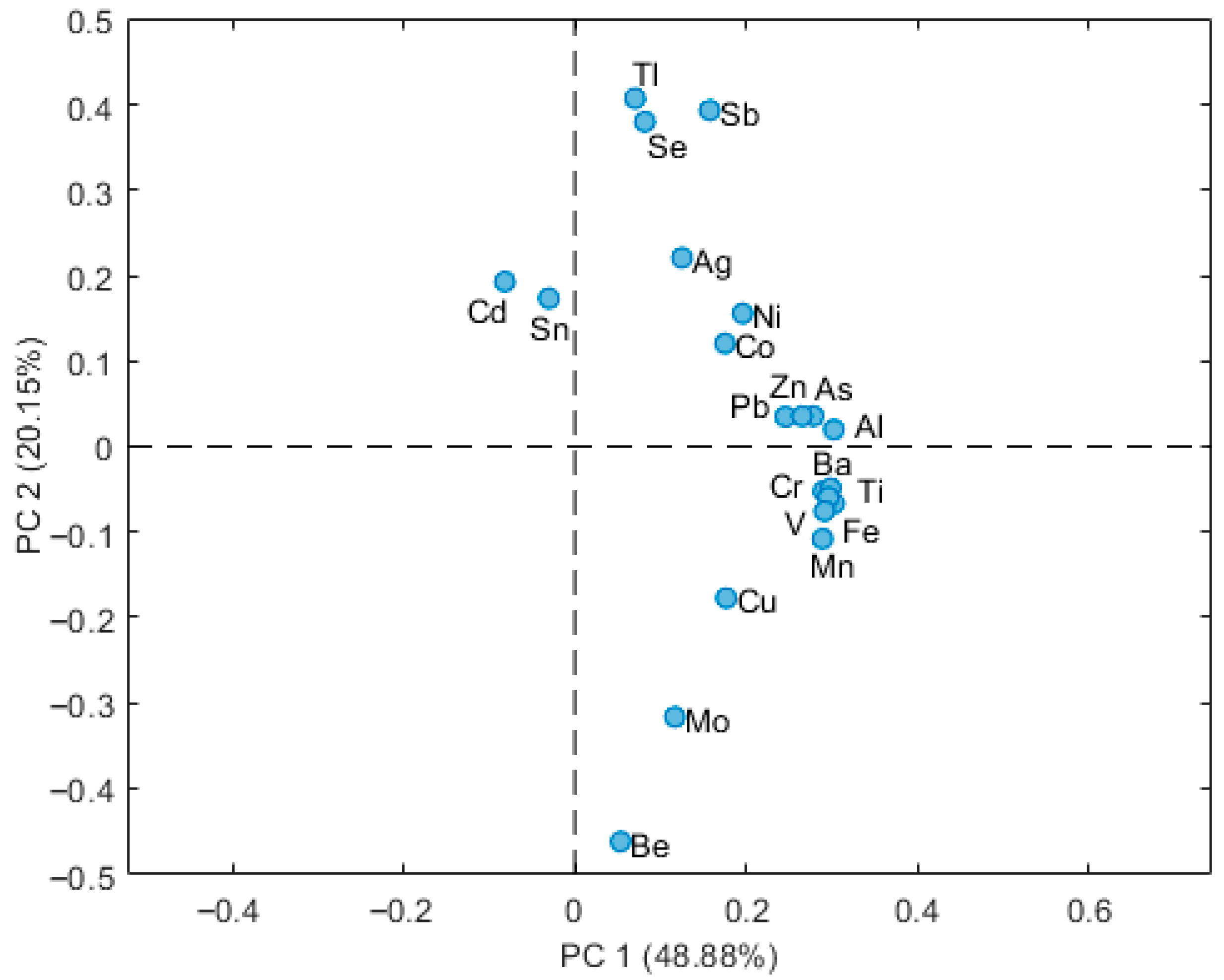


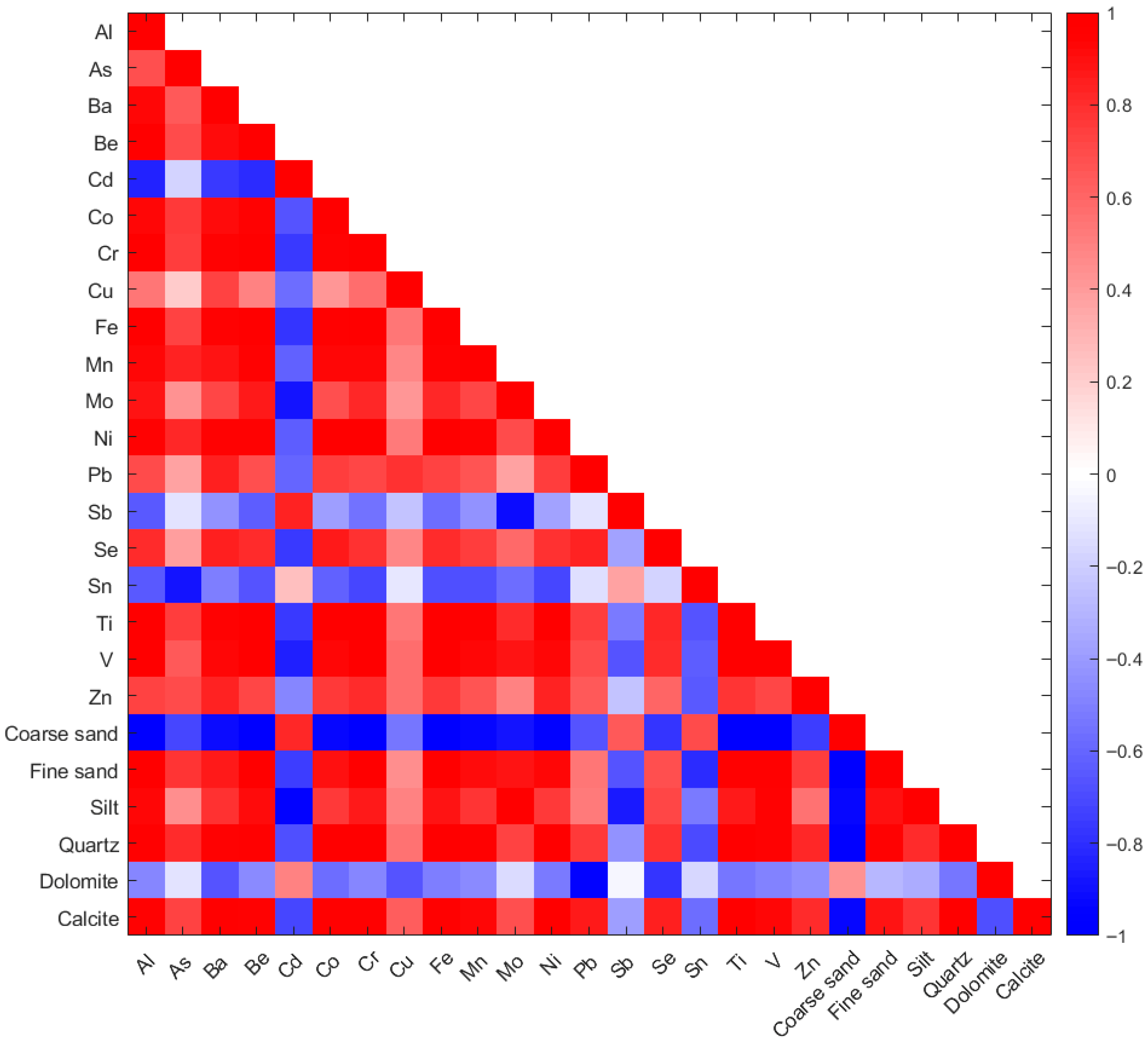
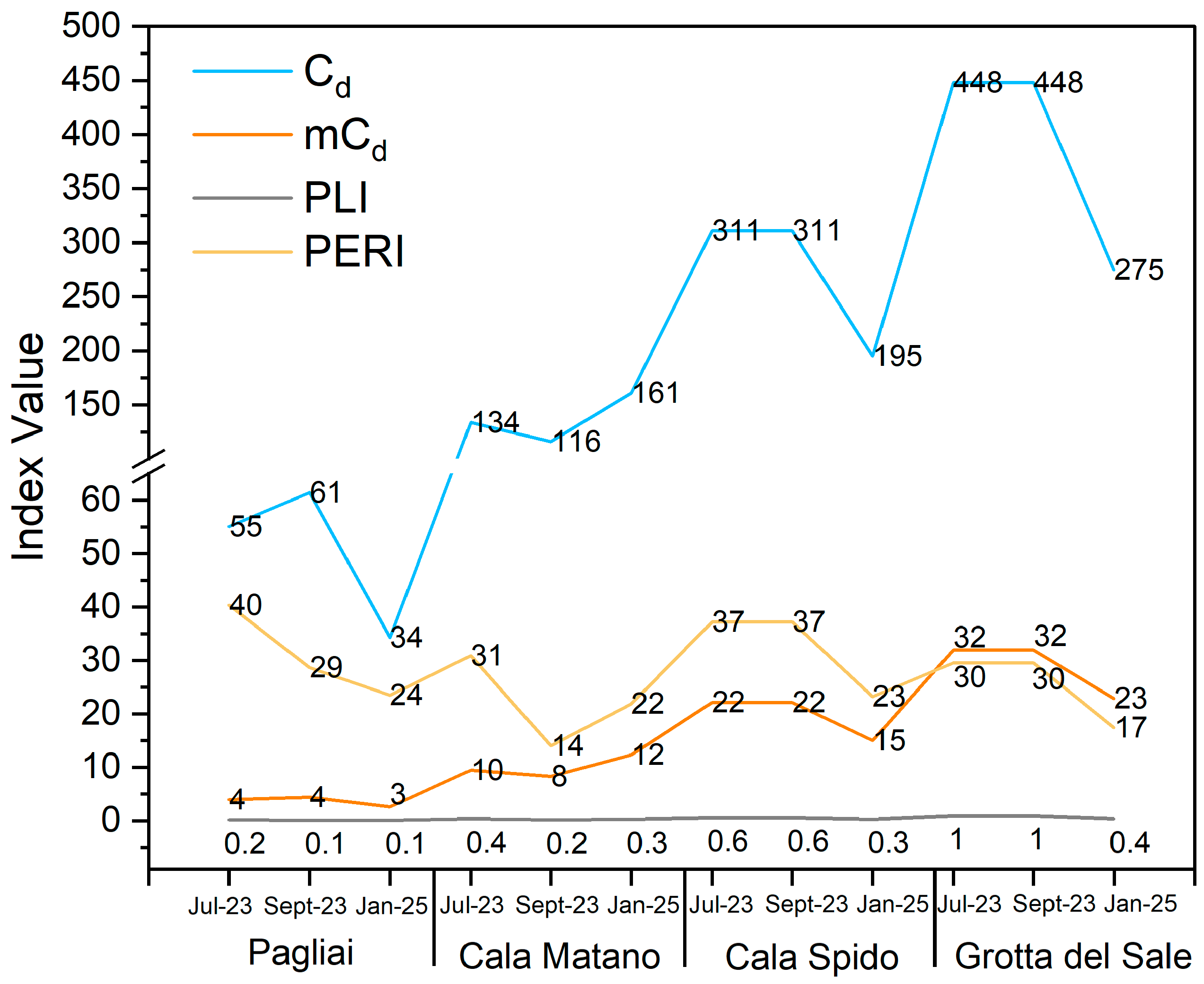
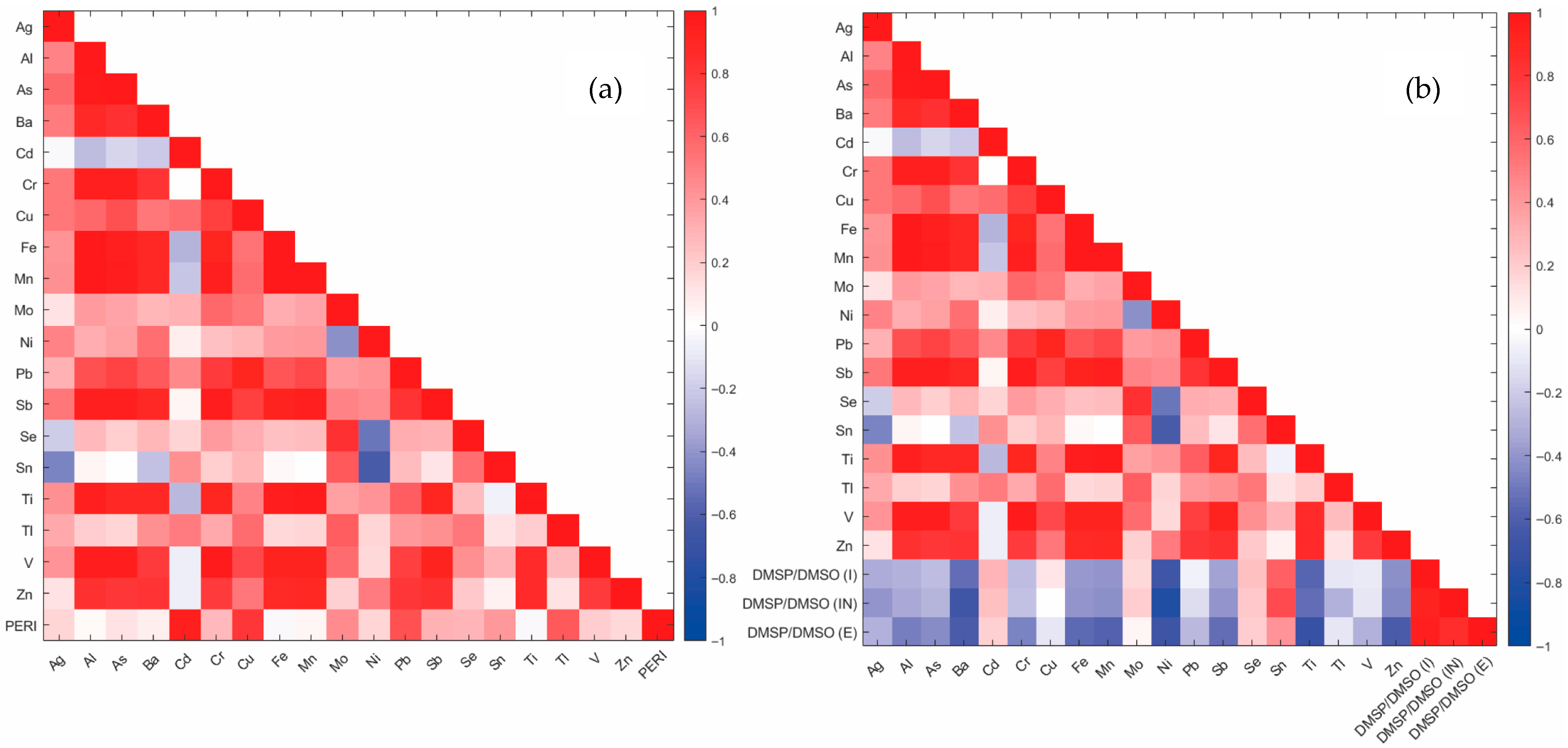
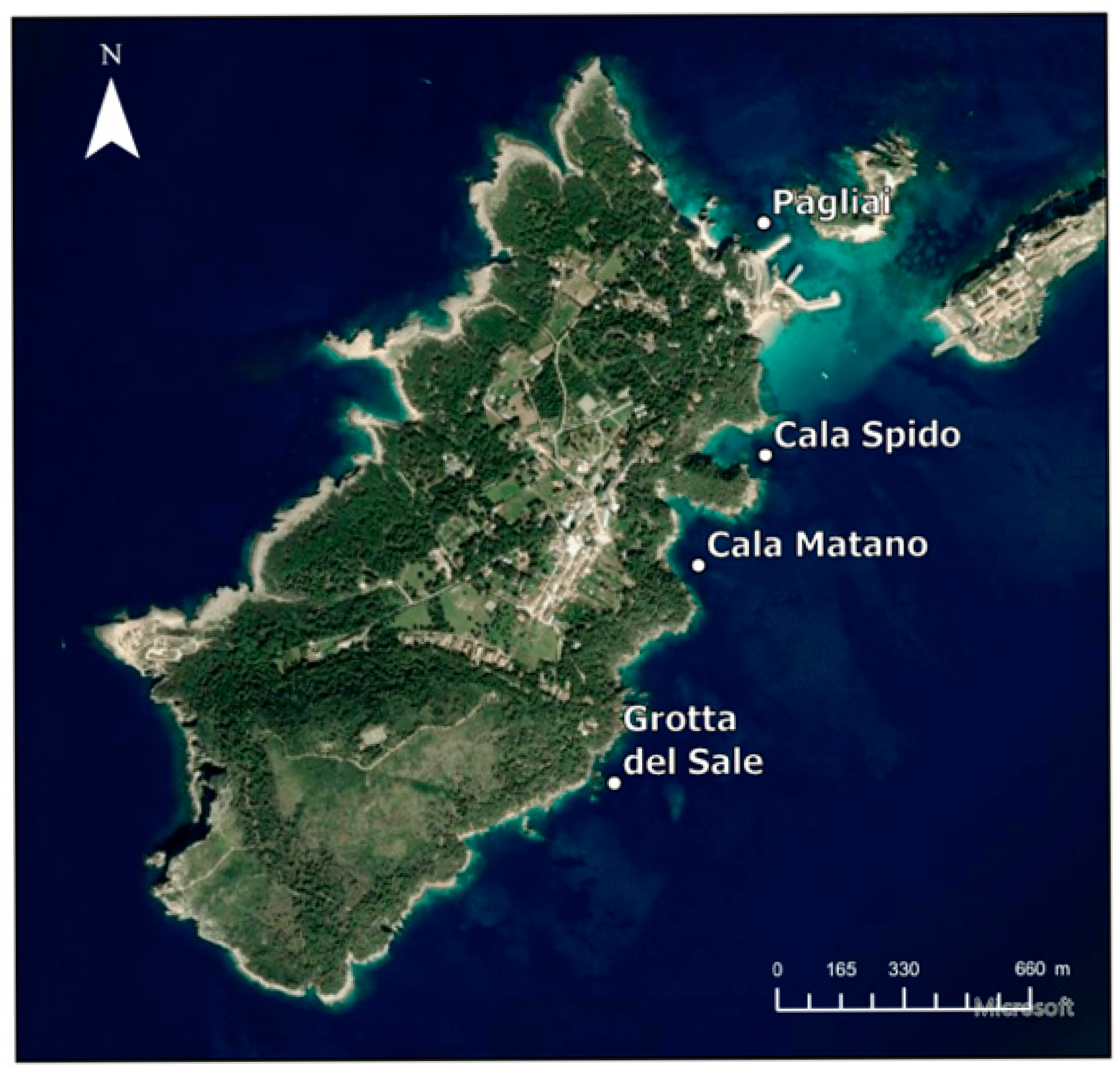
| Site | Value | Ag | Al | As | Ba | Be | Cd | Co | Cr | Cu | Fe | Mn | Mo | Ni | Pb | Sb | Se | Sn | Ti | Tl | V | Zn |
|---|---|---|---|---|---|---|---|---|---|---|---|---|---|---|---|---|---|---|---|---|---|---|
| P | Mean | nd | 458 | 2.26 | 6.44 | nd | 0.30 | 0.67 | 4.39 | 1.84 | 487 | 63.6 | nd | 2.04 | 3.08 | nd | 0.92 | nd | 9.81 | nd | 4.14 | 9.72 |
| SD | - | 31 | 0.29 | 0.42 | - | 0.01 | 0.07 | 0.23 | 0.82 | 23 | 9.2 | - | 0.19 | 0.09 | - | 0.08 | - | 0.15 | 0.04 | 2.60 | ||
| %F4 | nd | 9 | nd | 7 | nd | nd | nd | 12 | nd | 9 | 0.84 | nd | 3 | 24 | nd | nd | nd | 33 | nd | 5 | 45 | |
| CM | Mean | nd | 2.13 × 103 | 2.90 | 28.1 | 0.13 | nd | 1.54 | 8.73 | 6.1 | 1.76 × 103 | 95.8 | 0.14 | 5.22 | 11.5 | nd | 1.35 | nd | 47.5 | nd | 8.54 | 23.3 |
| SD | - | 111 | 0.16 | 6.9 | 0.02 | - | 0.34 | 0.50 | 5.0 | 62 | 9.2 | 0.01 | 0.02 | 2.1 | - | 0.16 | - | 5.3 | 0.04 | 10.4 | ||
| %F4 | nd | 61 | 45 | 31 | 55 | nd | 35 | 49 | 9 | 96 | 13 | 51 | 47 | 20 | nd | 8 | - | 78 | nd | 45 | 42 | |
| CS | Mean | nd | 2.51 × 103 | 4.62 | 24.6 | 0.15 | nd | 1.68 | 10.1 | 2.73 | 2.11 × 103 | 108 | 0.16 | 6.64 | 6.15 | nd | 1.15 | 0.28 | 57.7 | nd | 8.89 | 29.7 |
| SD | - | 29 | 0.03 | 8.8 | 0.01 | - | 0.08 | 0.2 | 0.35 | 66 | 2 | 0.01 | 0.45 | 0.06 | - | 0.12 | 0.08 | 2.1 | 0.06 | 8.0 | ||
| %F4 | nd | 47 | 32 | 27 | 43 | nd | 42 | 48 | 17 | 63 | 5 | 57 | 49 | 28 | nd | 8 | - | 48 | nd | 40 | 50 | |
| GS | Mean | nd | 5.21 × 103 | 3.34 | 31.4 | 0.24 | 0.19 | 1.72 | 11.9 | 3.92 | 3.05 × 103 | 110 | 0.42 | 6.31 | 6.80 | 0.77 | 1.30 | 0.40 | 81.8 | nd | 12.9 | 24.4 |
| SD | - | 202 | 0.08 | 0.4 | 0.01 | 0.01 | 0.04 | 0.4 | 0.12 | 242 | 8 | 0.04 | 0.28 | 0.23 | 0.04 | 0.01 | 0.08 | 0.8 | - | 0.76 | 11.1 | |
| %F4 | nd | 73 | 36 | 45 | 65 | nd | 59 | 74 | 26 | 88 | 14 | 11 | 72 | 64 | 102 | 29 | - | 74 | nd | 60 | 91 |
| Label | 1. P | 2. CM | 3. CS | 4. GS | ||||||||||||
|---|---|---|---|---|---|---|---|---|---|---|---|---|---|---|---|---|
| Cf | Igeo | EF | Ei | Cf | Igeo | EF | Ei | Cf | Igeo | EF | Ei | Cf | Igeo | EF | Ei | |
| As | 0.2 | −2.7 | 34,0 | 0.3 | −2.4 | 43.8 | 0.5 | −1.7 | 69.6 | 0.3 | −2.2 | 50.3 | ||||
| Cd | 0.7 | −1 | 110 | 22.1 | 0.6 | −1.4 | 86.1 | 17.1 | 0.7 | −1.2 | 101.3 | 20.2 | 0.5 | −1.7 | 70.7 | 14.1 |
| Cr | 0 | −5.5 | 5.2 | 0.2 | 0.1 | −4.5 | 10.3 | 0.3 | 0.1 | −4.3 | 11.8 | 0.4 | 0.1 | −4 | 14 | 0.5 |
| Cu | 0 | −5 | 6.9 | 0.2 | 0.2 | −3.3 | 23 | 0.8 | 0.1 | −4.5 | 10.3 | 0.3 | 0.1 | −3.9 | 14.8 | 0.5 |
| Mn | 0.1 | −4.2 | 12.4 | 0.1 | −3.6 | 18.6 | 0.1 | −3.4 | 21.1 | 0.1 | −3.4 | 21.5 | ||||
| Pb | 0.2 | −3.1 | 25.8 | 0.9 | 0.6 | −1.2 | 96.3 | 3.2 | 0.3 | −2.1 | 51.5 | 1.7 | 0.4 | −2 | 56.9 | 1.9 |
| Ti | 32.7 | 4.4 | 4.93 × 103 | 158 | 6.7 | 2.39 × 104 | 192 | 7 | 2.90 × 104 | 273 | 7.5 | 4.11 × 104 | ||||
| Zn | 0.2 | −2.9 | 30.5 | 0.2 | 0.5 | −1.6 | 73.1 | 0.5 | 0.6 | −1.3 | 93.2 | 0.6 | 0.5 | −1.6 | 76.6 | 0.5 |
| Cd | 34.3 | PERI | 23.5 | Cd | 161 | PERI | 21.9 | Cd | 195 | PERI | 23.2 | Cd | 274 | PERI | 17.4 | |
| mCd | 2.6 | AItot | 9.3 | mCd | 12.4 | AItot | 1.38 | mCd | 15 | AItot | 1.86 | mCd | 22.9 | AItot | 0.78 | |
| PLI | 0.1 | PLI | 0.3 | PLI | 0.3 | PLI | 0.4 | |||||||||
| Site | Long °E (gg pp ss.dd) | Lat °N (gg pp ss.dd) | Depth (m) | Temperature (°C) | |
|---|---|---|---|---|---|
| 1. | Pagliai (P) | 15°29′46.65′′ E | 42°06′43.13′′ N | 10.3 | 16.7 |
| 2. | Cala Spido (CS) | 15°29′45.89′′ E | 42°06′59.65′′ N | 10.0 | 16.9 |
| 3. | Cala Matano (CM) | 15°29′38.90′′ E | 42°06′50.24′′ N | 15.0 | 16.5 |
| 4. | Grotta del sale (GS) | 15°29′29.11′′ E | 42°06′31.94′′ N | 19.0 | 16.7 |
Disclaimer/Publisher’s Note: The statements, opinions and data contained in all publications are solely those of the individual author(s) and contributor(s) and not of MDPI and/or the editor(s). MDPI and/or the editor(s) disclaim responsibility for any injury to people or property resulting from any ideas, methods, instructions or products referred to in the content. |
© 2025 by the authors. Licensee MDPI, Basel, Switzerland. This article is an open access article distributed under the terms and conditions of the Creative Commons Attribution (CC BY) license (https://creativecommons.org/licenses/by/4.0/).
Share and Cite
Fattobene, M.; Russo, R.E.; Berrettoni, M.; Galindo-Riaño, M.D. Assessment of the Geochemical Availability and Ecological Risk of Trace Elements in Marine Sediments of the Tremiti Islands. Molecules 2025, 30, 4051. https://doi.org/10.3390/molecules30204051
Fattobene M, Russo RE, Berrettoni M, Galindo-Riaño MD. Assessment of the Geochemical Availability and Ecological Risk of Trace Elements in Marine Sediments of the Tremiti Islands. Molecules. 2025; 30(20):4051. https://doi.org/10.3390/molecules30204051
Chicago/Turabian StyleFattobene, Martina, Raffaele Emanuele Russo, Mario Berrettoni, and María Dolores Galindo-Riaño. 2025. "Assessment of the Geochemical Availability and Ecological Risk of Trace Elements in Marine Sediments of the Tremiti Islands" Molecules 30, no. 20: 4051. https://doi.org/10.3390/molecules30204051
APA StyleFattobene, M., Russo, R. E., Berrettoni, M., & Galindo-Riaño, M. D. (2025). Assessment of the Geochemical Availability and Ecological Risk of Trace Elements in Marine Sediments of the Tremiti Islands. Molecules, 30(20), 4051. https://doi.org/10.3390/molecules30204051












